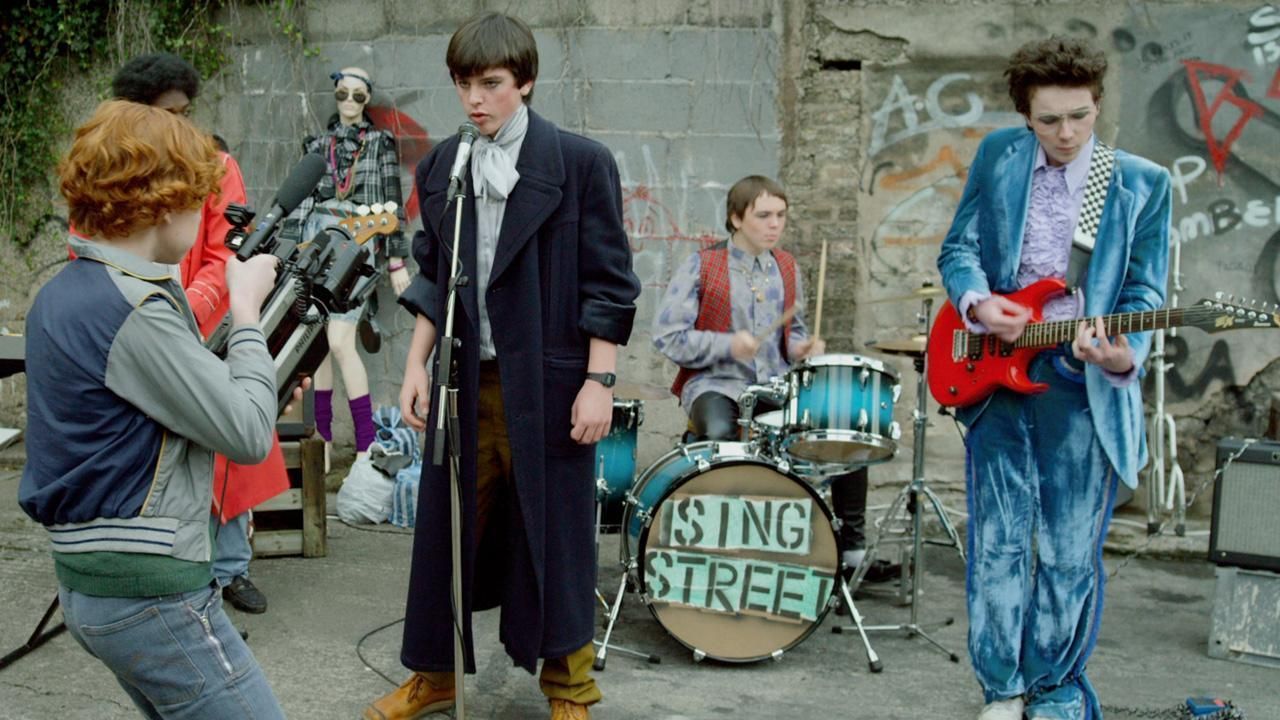
MPAA Rating: PG-13 | Rating: ★★★★½
Release year: 2016
Genre: Coming-of-Age, Music, Romance Director: John Carney
John Carney keeps making the same film. His first postmodern Irish musical, Once, followed an Irish busker and an Eastern European young mom as they discover a musical synergy. The film deservedly won an Academy Award for Best Song, and is wonderfully charming and romantic. Then there’s Begin Again, with Keira Knightley as a young musician and Mark Ruffalo as a washed-up producer who sees something magical in Knightley’s tunes. It, too, was wonderfully charming and romantic.
So it’s no surprise that Sing Street feels like a natural progression in this Irish musical trilogy of sorts. Sing Street is absolutely delightful, a coming-of-age story filled with catchy 1980s pop music and wonderfully charming and romantic performances. Did I say wonderfully charming and romantic yet? Because, yeah–it is.
Sing Street follows Conor (newcomer Ferdia Walsh-Peelo), a teenager in 1985 Dublin trying to navigate his stressful familial and scholastic life. His parents are on the verge of divorce, and a lack of income forces them to put Conor in a new school, an educational environment defined by chaos and bullies. Surrounded by a cloud of stress and anxiety, Conor does his best to keep his head down and survive his own life. That is, until he notices Raphina (Lucy Boyle), a mysterious and beautiful girl who lives near the school. Building up the courage, Conor invites Raphina to be a part of the music video his band is making. The only thing is–he doesn’t actually have a band. With some new friends from school, the “futurist” band Sing Street is formed in order for Conor to follow his heart. And so begins a beautiful journey of musical fantasy and romantic endeavors as Conor and Raphina become an unlikely couple, united by their wounds and their willingness to risk.
What Sing Street does so well is integrate the musical elements within the structure of a narrative–this truly is a musical, with the songs narrating the emotional arc of the story. Conor writes songs with the help of musical guru Eamon (Mark McKenna) and the encouragement from his older brother Brendan (Jack Reynor). The brotherly relationship between Conor and Brendan is central to the story, and Reynor gives the strongest performance out of the whole lot. Brendan offers lots of advice to Conor, but there’s more here than simply brotherly mentoring–Brendan seems to be living vicariously through his little brother, guiding him to take the risks Brendan could never take himself at that age. Brendan is far more complex than the typical stoner dropout trope; his narrative arc is just as satisfying and affecting as Conor’s and Raphina’s. While the film (sadly) doesn’t give much time or attention to the other members of the band–they’re essentially there to play music and make a quip or two at various moments–the weightiness and depth of the Conor/Raphina/Brendan story more than makes up for this neglect. So many other films would devolve into a conflict between the band members and Conor, whether he’d choose them or Raphina. Sing Street wisely doesn’t go this route, instead allowing Conor’s relationships to complement and inform the music.
Sing Street also gets teenagers right. I’m sure there could be critiques of the Raphina’s looks, arguing that no 16-year-old looks or acts like that. Or that Conor couldn’t possibly become so musically talented in such a short period of time (the film’s timeline spans a whole school year). Or that a few scenes play as unrealistic and melodramatic, particular some moments with bullies (the school principal, a shaved-headed profane classmate). But having worked alongside teenagers for over a decade, none of these felt out of the realm of possibility for me. I’ve met plenty of Raphinas; I’ve known musical prodigies like Conor; and any bully invited into a place of belonging may drop the surly facade for the sake of friendship. In fact, there are so many elements this film gets right about adolescence–the storm and stress of finding autonomy, the various identities teenagers try on like outfits, the need to find belonging, and the power of music as an effective and affecting emotional outlet for the internal turmoil of adolescence. As the music of Sing Street evolves, so do the band’s outfits–they literally wear their identity on their sleeve, something which feels decidedly like high school. The best scene in the film is a fantasy of a 1950s-style prom, with Conor and the band playing their music for a choreographed dance number involving ever major character within the film. Conor imagines everything is okay–his parents are happily together, the school principal is a cool guy after all, and the girl is totally infatuated with him. The whole scene plays out wonderfully, not only for its staging and editing, but for its bold depiction of what teenage romantic fantasies feel like. I was smiling the entire time.
There’s a moment in a conversation with Conor and Brendan where they’re describing the feeling of happysad, a difficult emotion to describe beyond music. Sing Street made me feel happysad. In fact, it made me feel all sorts of emotions–joy, grief, elation, anger, wonder. It’s a film about romance, family, growing up, and art. This is the epitome of a “feel good movie.” I’m still singing along with the tunes.
IMDB Listing: http://www.imdb.com/title/tt3544112/